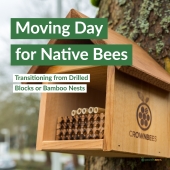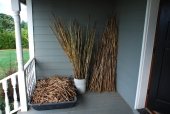Teasel is great (more later) because you can use it one year and then toss it to reduce parasite infestations. This is why most serious mason bee raisers do not use SOLID wooden blocks. Each year the pests get more and more populated. Think crop rotation and how the pests build up if you keep the same thing growing in the same place year in and year out.
One issue with teasel, and other reed, nesting material is parasitism. Wasps find them quite easy to penetrate and lay their eggs in the bee chambers.
I purchased a starter group of cocoons and a tray system from Crown Bees. The wood is more secure from pests and the tray system allows yearly cleaning without too much trouble.
OFF TOPIC
Teasel is not invasive. It is trying to tell you that there is some medical condition in your area that needs to be addressed!!! Teasel is GREAT for deep seated pain as in Lyme's disease or fibromyalgia. It actually expels the little beasties out of muscle tissue so that your body can deal with them. So, harvest all the teasel reeds you need, but say NICE things about it!!!










